Shield Report 2007; A surveillance scheme of occupational asthma in the Midlands |

|
VC Moore, S Manney, AS Robertson, MS Jaakkola, AD Vellore and PS Burge.
Occupational Lung Disease Unit, Heartlands Hospital, Bordesley Green East, Birmingham B9 5SS
SHIELD is the Midland Thoracic Society’s Surveillance Scheme for Occupational Asthma for the West Midlands. The scheme, which was set up in January 1989, was established to study the general and specific incidence of occupational asthma within the West Midlands region and Metropolitan County. The rate of reporting increased sharply in 2004, mainly due to a major outbreak, but since then we have seen a steady decrease in reports with 2007 having the lowest number so far with only 33 reports. We believe this is likely to be short lived however, with reports rising again in 2008.
The most common cause in 2007 was isocyanates (36%). Biocides and cleaning agents came second at 18%. Latex has increased slightly this year (2 reports rather than 1 person as in 2006), but still remains low suggesting that substitution of latex gloves is continuing.
94% of cases reported in 2007 were by the Birmingham Chest Clinic and 6% by others. We hope to increase the number notified by others this year with development of the MTS website. The most common method for the diagnosis of occupational asthma still remains a history of improvement of symptoms during holidays or periods off work. Some form of objective confirmation was sought in 81% of patients showing improvement away from work.
We still have plans for web based reporting, but there are higher priorities on the agenda and the plans remain on the shelf for the time being.
Introduction
Shield is a joint project between the West Midlands branch of the Society of Occupational Medicine and the Midland Thoracic Society. The scheme, which was set up in January 1989, was established to meet three main objectives. 1) To study the general and specific incidence of occupational asthma within a defined geographic area, 2) To determine proposed mechanisms of asthma, and 3) to audit diagnostic methods and objectives. Chest physicians and members of the West Midlands Group of the Society of Occupational Medicine implemented the scheme, by reporting each new case using a questionnaire format. The questionnaire covers confidential personal information on the patient, details of the diagnosis, information about their occupational history, and the outcome after diagnosis.
The last report on Shields progress was written in 2006 and summarised the information gained in that year, to that of previous years, 2005 and 2004. This report aims to update the participants of Shield by summarising the trends found in 2007 compared to those found in 2006 and 2005.
Outbreak of the year
We are still seeing workers from a school for children with special needs which was our outbreak of the year in 2006. We have seen 3 workers this year who have work-related symptoms, but not necessarily occupational asthma. This follows on from the 8 workers seen in 2006. The school itself employs around 110 workers. The cause of this outbreak is likely to be an acrylic tackifier used on flooring tiles.
Agent Awareness
The main agent reported to the scheme in 2007 was isocyanates. This was also joint first in 2006 and in second place in 2004 and 2005. The current problem seems to be mostly related to paint sprayers in small workplaces where exposure control is limited. Some workers are self employed and do not take time off work so serial peak flow measurements at and away from work are difficult. The graph below illustrates isocyanate exposure in single workplaces from 1991-2007, showing that most paint sprayers are from single workplaces rather than large factory outbreaks.
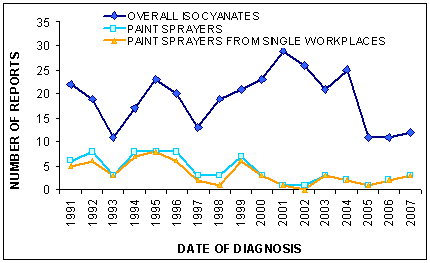
Shield Data
Number of Cases
The number of cases of occupational asthma reported to the Shield scheme is 33 so far. When the SHIELD report for 2006 was written, there were 57 cases notified, but now this figure is up to 66. It is difficult to compare notification for each year properly, as the last few years are likely to change, therefore the graph below is only as a guideline.
Figure 2 Number of cases diagnosed with occupational asthma between the years of 1980 and 2007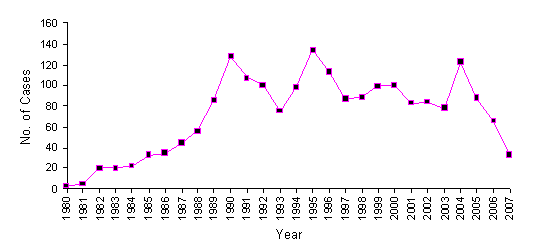
Personal details
In the year of 2007, 33 new cases have been reported to the scheme so far. There were 22 males (67 %), and 114 females (33 %). 26 (79%) of the new cases had no pre-existing asthma, and 18 (55%) had never smoked.
Reporting Hospital and Physician
The Shield scheme is confined to the West Midlands Region and the West Midlands Metropolitan County. In this region there are many chest physicians, hospitals, clinics and other organisations, which are known to the Shield scheme. However, many of these have not been asked to report over the last year due to the data protection issues. Therefore, in 2007, 31 (94 %) of the cases reported to Shield were through the Birmingham Chest Clinic, and 2 (6%) through other organisations. We are hoping that there will be more cases reported from other institutions in the coming year.
Suspected agents at work
In 2007 the most common reported agent that workers were exposed to was isocyanates (36%). The 2 most common in 2006 were isocyanates and oil mists (both 15.8%). Metal working fluid was also the most common in 2005 due to an outbreak starting in 2004. 434 cases of isocyanate suspected asthma have now been reported to the scheme, the first case being in 1978. 9 cases of isocyanate asthma were diagnosed in 2006 and 12 cases in 2005. Metal exposed cases are decreasing with only 1 notification being made in 2007.
The top five agents reported in 2007 were;
- Isocyanates 36% 12 cases
- Biocides/Cleaning agents 18% 6 cases
- Welding fume 9% 3 cases
- Latex 6% 2 cases
- Animals 6% 2 cases
Figure 3 Comparison of the percentage of patients exposed to the top five agents in 2007 to those exposed in 2006-2003.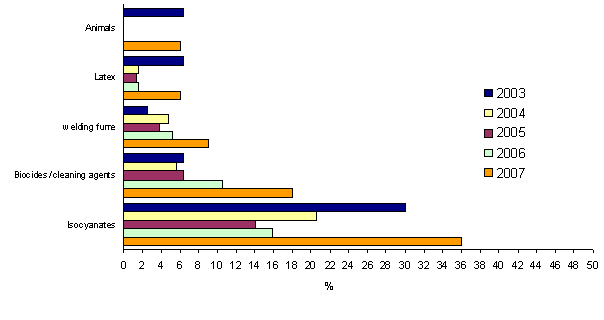
Employers and Jobs
There were 32 different employers reported to the scheme in 2007. 20 of these were new to the scheme.
Around 27 different jobs were reported in 2007, although it would be possible to group some of the specific jobs into broader categories (e.g. teachers). The most common job was nurse and paint sprayer at 9% each of all notifications in 2007.
Table 1 A list of the most common agents reported in 2007 with the corresponding jobs
| Agent Exposed |
Job |
| Isocyanates |
Foundry worker, knock-out, paint sprayer, paint shop supervisor, manufacturing associate, shop mobility worker, grinder of polyurethane foam, assistant manager, technician/foundry manager, foam production line worker |
| Biocides/Cleaning agents |
Pathologist, pharmacy technician, teacher, nurse, pool assistant, vehicle valet |
| Welding fume |
Spot welder, auto welder |
| Latex |
Nurse |
| Animals |
Dispatch Clerk |
Methods used for diagnosis
The methods used for diagnosis that are documented on the shield form are; 1) Improvement on holiday, 2) Improvement off work, 3) Serial peak flow charts, 4) Specific IgE, 5) Methacholine at work, and 6) Methacholine away from work and 7) Specific bronchial provocation tests. 27 cases were documented as improving off work and on holidays. Of these, 22 cases had at least one other investigation. The most common investigation was serial peak flow charts (23 cases) followed by specific IgE (15 cases). There were 20 specific challenges performed in 2007, but only 5 of these were on patients diagnosed in 2007.
Table 2 Percentage use of each method of diagnosing occupational asthma in 2006, 2005 and 2004.
| Method |
% 2007 |
% 2006 |
% 2005 |
| Improving on holidays |
91 |
93 |
83 |
| Improving off work |
85 |
82 |
91 |
| Serial peak flow |
70 |
67 |
86 |
| Specific IgE |
45 |
37 |
60 |
| Methacholine at work |
39 |
46 |
50 |
| Methacholine away from work |
33 |
26 |
26 |
Specific Bronchial Challenge
(positive challenges) |
15
(6) |
7
(3.5) |
10
(8) |
Proposed method of asthma
Figure 4 shows the proposed mechanism of asthma in patients with diagnosed occupational asthma in 2007, 2006 and 2005. In 2007 the most commonly reported mechanisms of asthma were allergic (55 %) and unknown (30 %). In 2006 allergic and unknown mechanisms were also reported in most cases (56% and 30% respectively). The percentage of ‘no answer’ has risen slightly in 2007 to 15% from 12% in 2006 and an average of 8% over the 2 years before that. The other mechanisms (irritant and direct pharmacological effect) have not been used this year.
Figure 4 Proposed mechanisms of asthma in 2007, 2006 and 2005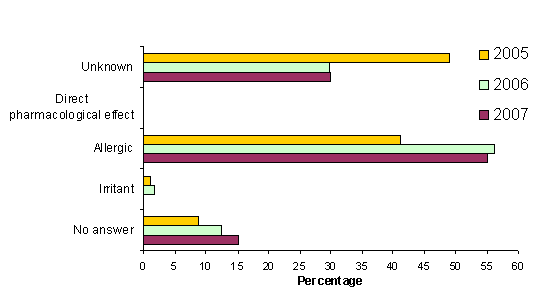
Subsequent History
The subsequent history of the patients diagnosed with occupational asthma in 2007 is shown in Figure 5. There are a similar amount of workers remaining exposed, moving within the same workplace or changing their job for alternative employment. The number off sick has decreased this year and the amount that has had the agent removed at work has risen slightly. This is probably less likely to happen where only one or two workers are having problems in a workplace. Relocation at work probably remains the most effective solution in most cases. The recorded subsequent history of the patient is taken at diagnosis and is subject to change so these figures will change with time.
Figure 5 Subsequent history of patients diagnosed of occupational asthma in 2007, 2006 and 2005 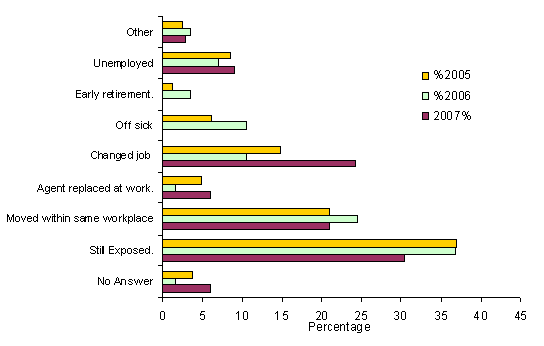
Gold Standards
A gold standard occupational asthma case is defined by either; 1) Bronchial challenge test, 2) A four fold change in their bronchial reactivity with a good history, or 3) Positive IgE with a good history, and all of these can be accompanied by a good quality PEF record. 12% of cases have become gold standards in 2007 so far.
Future Developments
The BTS standards of care for occupational asthma have recently been published (Fishwick D et al. Standards of care for occupational asthma, Thorax, 2008; 63 : 240-250). It recommends auditing the following items which have now been added to the Shield report form. See Standards of care for occupational asthma for more information and full paper.
All patients with suspected occupational asthma should have the following clearly documented in the medical case notes by the second consultation:
- A full list of occupations held and likely associated occupational exposures.
- FEV1 and FVC.
- If at work, serial PEF measures taken for at least four continuous weeks including rest days with at least four good quality readings per day analysed by a validated method.
- If exposed to allergen with appropriate specific IgE measure or skin prick test, the result of this test.
- Letter to patient concerning advice about continuing employment once a diagnosis has been made.
- Compensation advice appropriate to the case.
The problems with the Shield scheme are lack of reporting, a need for constant updating and a lack of resources. We have solved the data protection issues and will start to request notifications from other institutions. We would like to add web based reporting to improve notification and updating but this is on hold for the time being due to time constraints. There are organisational and technical changes to be made to improve accuracy and to help keep data up to date. We have plans for these but there is no date set for implementation as yet. The development of a better internet site for the Midlands Thoracic Society this year should help.
Conclusions
Occupational asthma remains a serious disease causing much morbidity, and is potentially preventable. The Health and Safety Executive are currently emphasising the need to control occupational asthma. Workers in small paint shops are among those who have been most reported this year and should be studied to assess the development of occupational asthma.
Comments
Please sign in or register to add your thoughts.